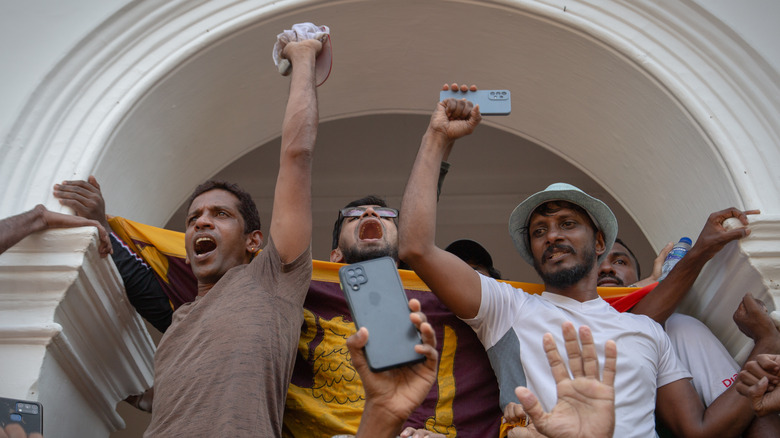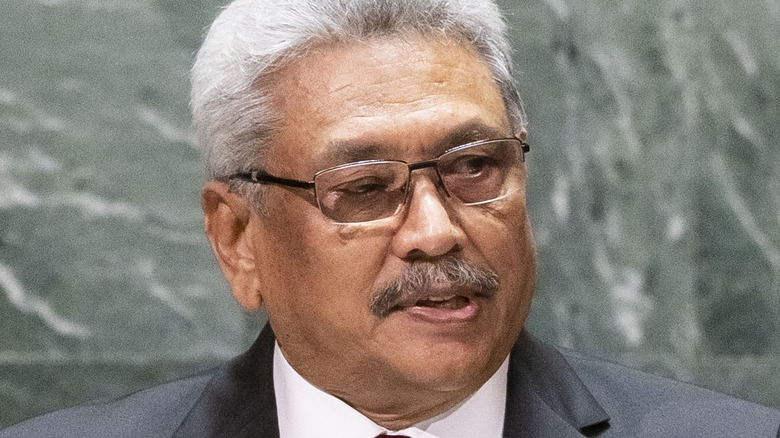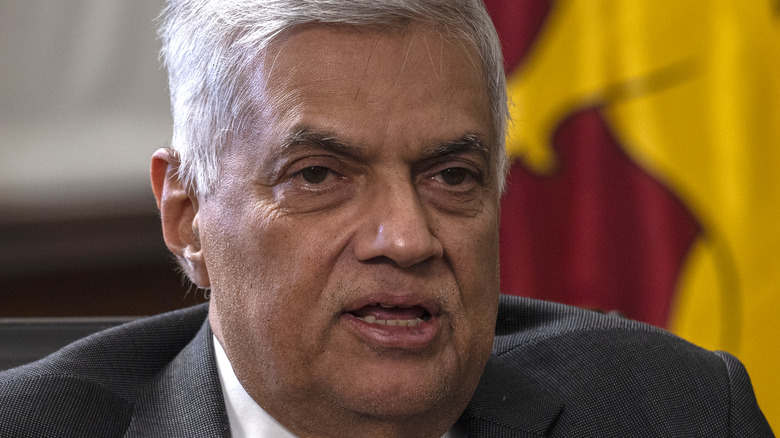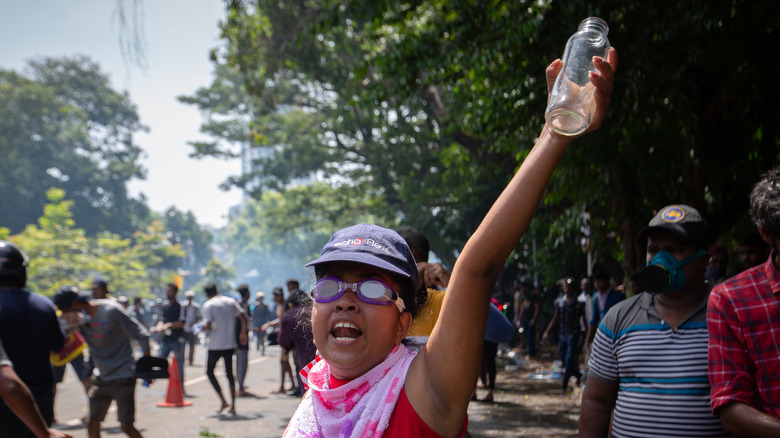Government Protests In Sri Lanka Explained
In July, 2022 Sri Lankan President Gotabaya Rajapaksa fled the country without resigning. Rajapaksa reportedly planned to step down after a prolonged period of social and political unrest in the country. Those demonstrations included an invasion of Rajapaksa's home and presidential offices only a few days prior to Rajapaksa's departure, according to reporting from Foreign Policy. In the aftermath, the vacancy left by President Rajapaksa was filled by Sri Lankan Prime Minister Ranil Wickremesinghe.
Per the Sri Lankan constitution, the prime minister assumes power should the president become ill or otherwise unable to fulfill their duty, according to CNN. Enraged by high inflation, soaring gas prices, and widespread shortages, Sri Lankan demonstrators — dubbed "Aragalaya," or "struggle" in Sri Lanka's most-common language, Sinhala (per Britannica) — demanded that Wickremesinghe also step down and be replaced by a new form of government. With no resignations forthcoming, the social and political upheaval in the country only worsened, as CNN goes on to report.
The current Sri Lankan crisis took shape one year earlier
As the Qatar Embassy in Colombo, the Sri Lankan capital city, explains on their website, Sri Lanka is ostensibly a democratic republic. It has a unitary state or a strong central government that blends aspects of the U.K.-style parliamentary system with presidential powers similar to the U.S. Though many pressures of the civic and social unrest which boiled over in mid-summer 2022 had been building for some time, the roots of the current anti-government uprising in Sri Lanka largely began one year earlier, according to Foreign Policy.
It was then that a coalition of Sri Lankan farmers and trade unions took a stand against proposed cuts in government farm subsidies and a ban on imported fertilizer. Those policies would threaten crop yields, in the view of the demonstrators. At that point, the rich multi-ethnic and religious fabric of Sri Lankan society was already strained by poverty, high inflation, and food shortages, worsened by a COVID-19 pandemic-caused dip in tourism. At that point, though, the Sri Lankan government managed to mostly tamp down the uprising, as Reuters reports.
In spring, 2022, the Sri Lankan uprising took on new urgency
Sparks of the massive Sri Lankan unrest lay mostly dormant one year later, when a group Sri Lankan dissidents sought to renew the movement, as Reuters notes. Few of the social and economic demands from Sri Lankan protestors were satisfied, though the controversial ban on foreign fertilizer had been reversed in response to pushback. With all-time high gas prices influenced in no small part by the Russian invasion of Ukraine, among other factors, as well as paralyzing government debt and foreign currency shortages, the Sri Lankan government turned to the International Monetary Fund (IMF) for a bailout.
Per those talks, the IMF would also allow Sri Lanka to restructure their debt, among other types of relief. As of this report, those Sri Lankan negotiations with the IMF were ongoing, according to another Reuters report. All combined, the current Sri Lankan anti-government movement found new footing throughout late spring and early summer of 2022, as new factions gathered strength through combinations of in-person and online recruitment, as further reporting from Reuters explains. Layered on top of other economic and social issues were burdensome power cuts. The demands of this renewed uprising was a complete overthrow of Sri Lanka's government. By May, 2022 the movement had made some progress.
Sri Lankan President Gotabaya Rajapaksa's brother, Mahinda, was prime minister
The first Sri Lankan government official to fall under pressure from the Aragalaya movement was President Gotabaya Rajapaksa's (pictured) older brother, Mahinda, who at that time served as the Sri Lankan prime minister (via Reuters). In May, 2022, and only a matter of months before Sri Lankan anti-government demonstrators invaded the president's home and offices, Mahinda Rajapaksa stepped down and another member of Rajapaksa family quit his post as a lawmaker. Still dissatisfied, the Aragalaya movement demanded President Gotabaya Rajapaksa also step aside, but in the early days of the more recent uprising, he refused.
By July, 2022, using social media to spread the word, an estimated 200,000 Sri Lankan citizens marched on Colombo, as President Rajapaksa and Prime Minister Ranil Wickremesinghe fled to secure locations. Overpowering guards and breaking through barricades, and in defiance of government curfews, the Sri Lankan presidential residence and offices were then occupied. Wickremesinghe's home was also attacked and burned (per Reuters). Speaking with Reuters, Sri Lankan playwright and Aragalaya member Ruwanthie de Chickera said, "I think it is the most unprecedented gathering in this country. Full stop."
Rajapaksa agreed to step down
With several government buildings occupied, Sri Lankan President Rajapaksa said he'd resign only a matter of days after the renewed uprising reached its apex. In response to that power vacuum, though, then Prime Minister Wickremesinghe stepped in, flouting the demands of the protestors. NPR quotes Wickremesinghe as saying, "A government has to function according to the law. I am here to protect the constitution and through it fulfill the people's demands. What we need today is an all-party government and we will take steps to establish that." With success in their grasp, and as an ever increasing number of Sri Lankan government officials stepped aside, Aragalaya representatives began to plan their country's new government.
Demonstrators also rejected the established order's offer to transition Sri Lanka from a unitary state to a more inclusive all-part government in lieu of resignations, based on reporting from Al Jazeera. Per their demands, the new system would exclude the Rajapaksa family's Sri Lanka Podujana Party (SLPP) entirely. Instead, an interim government would be put in place for at least a year. That government would be overseen by the newly-formed People's Council made up of "Janatha Aragalaya," or the people's struggle. Aragalaya also asked for a new constitution and fewer executive powers as well as strengthened democratic institutions, among other stipulations, as outlined by Al Jazeera.
The Sri Lankan president fled the country
Only a matter of hours before Rajapaksa was expected to step down as president, he left Sri Lanka for the Maldives, along with members of his family and bodyguards, as reporting from NBC News explains. Though Wickremesinghe remained in power, reaction to Rajapaksa's departure was mixed among the large number of Aragalaya demonstrators. As the protestor Tharindu Jayawardana said (via NBC News), "In a way, it's good that he left ... If he had stayed behind, he wouldn't have been able to survive. He was selfish to save his own hide."
The lack of a formal resignation, and with Wickremesinghe still in power, other Sri Lankan dissidents were unsatisfied. Shiromi Fernando also said (via NBC News), "I was so angry ... He destroyed this country and left." In response to the ongoing uprising, and after instituting a national curfew, acting Sri Lankan President and Prime Minister Wickremesinghe spoke to the nation. In his address, Wickremesinghe said (via NBC News), "Protesters are attempting to prevent the appointment of a new president. This fascist threat must be removed." As of this report, Wickremesinghe remained in hiding.





